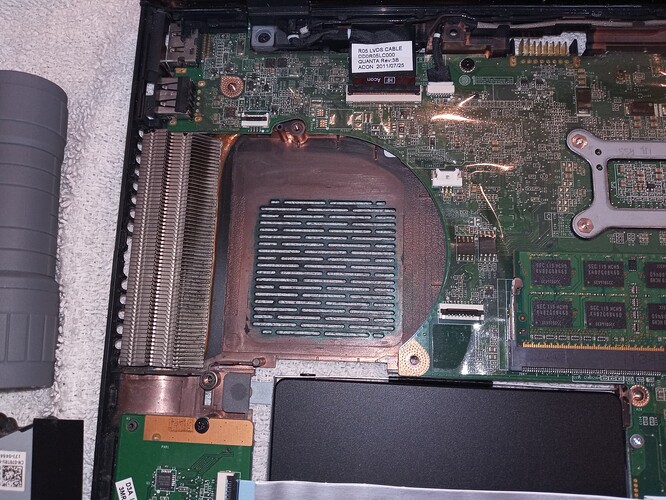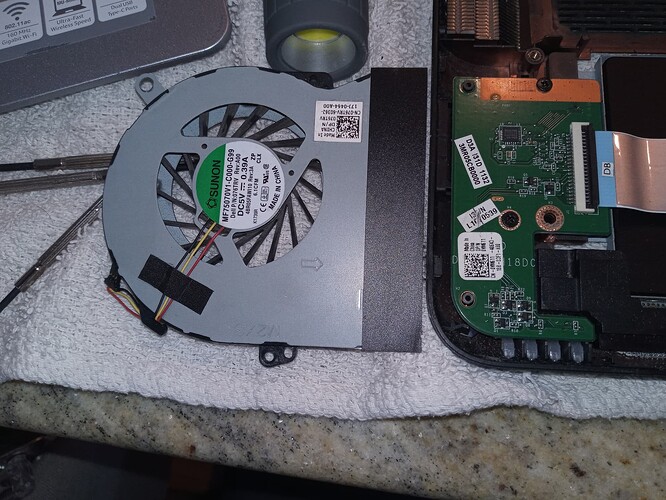@Mr_Magoo , What shape/configuration do u recommend putting the paste on as? some people put it in the form/shape of an X?
Are you saying apply it evenly in an even square shape?
As thin as possible but also to where the paste connects entirely the surfaces of the heatsink & the chip?
I put three thin lines equidistant, then use an old credit card to spread it evenly across the entire surface.
After you've got an evenly-distributed and thin layer of paste, put your heat sink down onto the chip, twist it 360 degrees left, 360 degrees right, then bolt it down, tightening each screw by the same small amount in succession to achieve an even pull.
So you snug the screws lightly, then tighten each screw by a fraction of a turn before moving onto the next screw, until all the screws are equally tight. Do not overtighten, do not tighten unevenly... you can strip the threads or break your chip. There should be a torque spec available for your CPU and heat sink.
@Mr_Magoo ,thank you for all the advice. One more thing, how different is the approach of putting thermal paste on the heatsink of a laptop compared to a desktop? i've heard the approach/method is different. -Thanks!
I've never treated them differently except that one must be more careful to clean up any paste that squishes out of the gap on a laptop, since other components are closer by. Since laptops tend to get taken apart less often, it's more important to use a paste that either dries out more slowly or it doesn't matter if it dries out (diamond paste).
Another pro-tip... I've found the quickest way to remove the old thermal paste is those white "magic eraser" microfiber sponges that your wife probably has in the kitchen for scrubbing pots and pans.

Thank you! Very helpful. ![]()
Gday @anon59566361
If you feel you have resolved the issue,
Could you please 'Mark' the post that helped as "Solution".
Or add a post explaining your Solution.
This lets Others know they can find a solution here that may help them.
Thank you.
Zorin Forum Community.
@Mr_Magoo , thank you for all your advice,
I cant find the torque specs for the heatsink screws for my Dell Inspiron 14z-N411z, I dont want to screw it too tight. What should i do?
Here is the dell. com manual. Please help.
Also what does torque specs mean? what do torque specs even look like?
-Thanks!
This is probably way overkill, but:
Everything you've never wanted to know about heat sink mounting:
Basically, if you can wiggle the heatsink after you've tightened the screws, it's too loose, but you should never go over ~60 pounds-force total on the face of the CPU. So ~15 pounds-force per screw maximum, which, depending upon thread pitch, you can calculate the exact torque to use on the screws using the PDF above. Given the (usually) fine thread pitch of most CPU heatsink screws, it won't take as much as you think... so just snug the screws, grab the heat sink and try to wiggle (rotate) it a bit.
It helps if you've got something like this:
https://www.harborfreight.com/10-50-in-lb-precision-torque-screwdriver-set-22-piece-58950.html
I used to use hex-head screws, rather than the Phillips-head screws provided, for computers that would be taken apart more than a few times (the slots tend to get torn up after many disassemblies because the provided screws are cheap soft metal)... it's really easy to overtorque hex-head screws, so I used a torque screwdriver. It's also recommended to use them if you're putting a heavy heatsink on, since I've had a few times that the OEM screws eventually broke due to the weight (thermal cycling causes metal fatigue and being soft metal, they give way). It also helps, if you've got a really heavy heatsink, to put backing nuts on the backside of the motherboard... but they've generally got to be plastic (or plastic-lined castle nuts) so they don't short anything out. Back in the day, some heat sinks were so heavy that they needed a metal backing plate so the motherboard didn't flex due to the weight.
@Mr_Magoo ,Thanks! what kind of precision screwdriver would you recommend i buy? does it need to be electronic?
No, the type that clicks when you hit the specified torque work well enough. Be sure that you're ordering one that measures in inch-pounds, not foot-pounds... you do not want to be torquing those bolts with foot-pounds of torque. ![]()
@Mr_Magoo , this video here says delidding is better than lapping?
@Storm , @Mr_Magoo , i removed the fan & cleaned it(photo is of fan removed).
& cleaned the vents, there was a ton of black fuzz/lint inside that i coudnt see originally, burnt looking, very disturbing, 10 years worth. it is running so much better now. I am a bit intimidated about doing the lapping, thermal paste & all that tho.
In the photo u can see the heat pipe underneath the vent on the left. 2nd photo is of the fan, i analyzed it & it seems to be working/spinning very smoothly,noiselessly, & in great condition despite being 10 years old.
Do not delid unless you're willing to void the warranty on your CPU (and possibly your entire computer), you buy the special delidding hardware, you practice a bit on older (scrap) CPUs (trust me, you'll mess it up the first time unless you're very, very careful) and for all that is holy, DO NOT use "liquid metal" as your heat sink paste.
Think about it... you're mixing possibly tin, possibly lead, possibly antimony, definitely gallium, definitely indium. And you're applying that to the metal on top of the CPU and the bottom of the heat sink (which can be copper or aluminum).
The gallium tends to 'soak into' other metals... with aluminum it'll soak in and make it so brittle it crumbles to the touch.
Then you've got galvanic corrosion... in a hot environment without humidity control... definitely a recipe for ruining your CPU in a few short years.
And "liquid metal" is electrically conductive... splatter one tiny little droplet where it shouldn't be and it'll spread out and soak in, shorting out contact pins. It's impossible to remove.
You might think about running a pipe-cleaner down through the fins to make sure everything is cleaned out. Be very careful... they're thin and they bend easily. Use small pipe cleaners.
Thanks for all the help @Mr_Magoo !, unfortunately i dont have any pipe cleaners, I will get some, nor do i have compressed air. Also, I didnt have a chance to take apart my laptop anymore than i did, but i need to check on the heatsink & if its dirty.
This topic was automatically closed 90 days after the last reply. New replies are no longer allowed.


